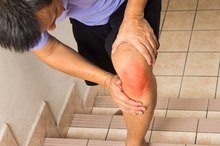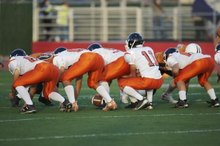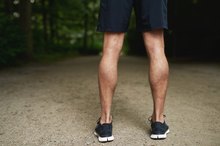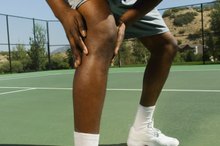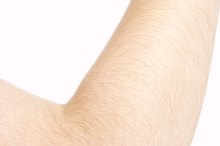Signs & Symptoms of a Hyperextended Knee
Hyperextended knee injuries occur frequently. The knee can easily be stretched or twisted in a way that tears ligaments and causes intense pain, discomfort or long-lasting effects. There are immediate signs that you might have hyperextended your knee, and symptoms that continue days after the injury.
If you are experiencing serious medical symptoms, seek emergency treatment immediately.
What is Hyperextension?
A hyperextended knee injury occurs when the knee extends past a normal range of motion in the straight position. Essentially, the knee bends back on itself. Hyperextension can range from a mild injury, which is sore but heals in two to four weeks, to a severe injury requiring surgery and extensive knee pain medicines.
- A hyperextended knee injury occurs when the knee extends past a normal range of motion in the straight position.
- Hyperextension can range from a mild injury, which is sore but heals in two to four weeks, to a severe injury requiring surgery and extensive knee pain medicines.
Immediate Symptoms
Pain in the Knee & Occasional Popping When Walking
Learn More
You will experience several symptoms right away if you hyperextend your knee and will recognize the need for knee pain help. You might hear or feel a pop, and it might feel as if your knee has been thrown out of line. You will experience pain at the back and sides of your knee, and swelling within the first few hours of the injury. Most significantly, you will be unable to continue playing, running, etc., on your knee. The knee may become unstable, but instability is not always readily noticed because of the swelling. You might be able to walk on it, but it will be painful.
- You will experience several symptoms right away if you hyperextend your knee and will recognize the need for knee pain help.
When to Seek Care for a Hyperextended Knee
If you have been injured enough that your knee is swelling, feels unstable or there is impaired motion or pain, you should seek knee pain treatment and be evaluated by your health care provider as soon as possible. Do not try and diagnose or treat knee injuries on your own. The knee is a complex joint and can have many different injuries. Proper treatment of those injuries is imperative for full recovery 1.
- If you have been injured enough that your knee is swelling, feels unstable or there is impaired motion or pain, you should seek knee pain treatment and be evaluated by your health care provider as soon as possible.
Time Frame: Recovery from Hyperextended Knee Injury
Ligament Tear & Knee Hyperextension
Learn More
A mild hyperextension of the knee may require only two to four weeks to heal. Rest and physical therapy will be the primary modes of treatment, and knee pain medicines may be prescribed. A knee that has experienced a ligament tear during the injury may require surgery and will likely require physical therapy and six to nine months of convalescence before returning to athletic activity.
Treatment
Immediate treatment of a hyperextended knee should include using crutches, elevating it when you are sitting or lying down and icing your injury. Acetaminophen also can reduce pain. Knee pain treatment will depend on the severity of the injury. Rest and physical therapy may be required for a mild hyperextension, while surgery may be an option for a hyperextension that has resulted in a ligament tear.
- Immediate treatment of a hyperextended knee should include using crutches, elevating it when you are sitting or lying down and icing your injury.
Related Articles
References
- WebMD: Anterior Cruciate Ligament Injuries
- Lespasio MJ, Piuzzi NS, Husni ME, Muschler GF, Guarino A, Mont MA. Knee Osteoarthritis: A Primer. Perm J. 2017;21:16-183. doi:10.7812/TPP/16-183
- Kiapour AM, Murray MM. Basic science of anterior cruciate ligament injury and repair. Bone Joint Res. 2014;3(2):20-31. doi:10.1302/2046-3758.32.2000241
- Doral MN, Bilge O, Huri G, Turhan E, Verdonk R. Modern treatment of meniscal tears. EFORT Open Rev. 2018;3(5):260-268. doi:10.1302/2058-5241.3.170067
- Reinking MF. CURRENT CONCEPTS IN THE TREATMENT OF PATELLAR TENDINOPATHY. Int J Sports Phys Ther. 2016;11(6):854-866.
- Petersen W, Rembitzki I, Liebau C. Patellofemoral pain in athletes. Open Access J Sports Med. 2017;8:143-154. doi:10.2147/OAJSM.S133406
- Frush TJ, Noyes FR. Baker's Cyst: Diagnostic and Surgical Considerations. Sports Health. 2015;7(4):359-65. doi:10.1177/1941738113520130
- Huang YC, Yeh WL. Endoscopic treatment of prepatellar bursitis. Int Orthop. 2011;35(3):355-8. doi:10.1007/s00264-010-1033-5
- Beals C, Flanigan D. A Review of Treatments for Iliotibial Band Syndrome in the Athletic Population. J Sports Med (Hindawi Publ Corp). 2013;2013:367169. doi:10.1155/2013/367169
- Tsai CH, Hsu CJ, Hung CH, Hsu HC. Primary traumatic patellar dislocation. J Orthop Surg Res. 2012;7:21. doi:10.1186/1749-799X-7-21
- Ragab G, Elshahaly M, Bardin T. Gout: An old disease in new perspective - A review. J Adv Res. 2017;8(5):495-511. doi:10.1016/j.jare.2017.04.008
- Lee PYF, Nixion A, Chandratreya A, Murray JM. Synovial Plica Syndrome of the Knee: A Commonly Overlooked Cause of Anterior Knee Pain. Surg J (N Y). 2017;3(1):e9-e16. doi:10.1055/s-0037-1598047
- Vaishya R, Azizi AT, Agarwal AK, Vijay V. Apophysitis of the Tibial Tuberosity (Osgood-Schlatter Disease): A Review. Cureus. 2016;8(9):e780. doi:10.7759/cureus.780
- Zanon G, Di vico G, Marullo M. Osteochondritis dissecans of the knee. Joints. 2014;2(1):29-36.
- Hindle P, Davidson E, Biant LC. Septic arthritis of the knee: the use and effect of antibiotics prior to diagnostic aspiration. Ann R Coll Surg Engl. 2012;94(5):351-5. doi:10.1308/003588412X13171221591015
- Gwinner C, Märdian S, Schwabe P, Schaser KD, Krapohl BD, Jung TM. Current concepts review: Fractures of the patella. GMS Interdiscip Plast Reconstr Surg DGPW. 2016;5:Doc01. doi:10.3205/iprs000080
- Voskuil R, Evenski AJ, Montgomery C, Emory CL. Malignant Bone Tumors of the Knee: How to Identify and Treat. J Knee Surg. 2019;32(4):305-314. doi:10.1055/s-0038-1675828
- Gupte C, St mart JP. The acute swollen knee: diagnosis and management. J R Soc Med. 2013;106(7):259-68. doi:10.1177/0141076813482831
- American Academy of Orthopedic Surgeons. Unstable Kneecap.
- Bhatia D, Bejarano T, Novo M. Current interventions in the management of knee osteoarthritis. Journal of Pharmacy & Bioallied Sciences 2013 Jan-Mar;5(1):30-38. doi:%2010.4103/0975-7406.106561
- Bronstein RD, Schaffer JC. Physical Examination of the Knee: Meniscus, Cartilage, and Patellofemoral Conditions. J Am Acad Orthop Surg. 2017 May;25(5):365-374.
- Browne K, Kurtz CA. How to perform a comprehensive examination of the knee. JAAPA. 2009 Jun;22(6):20-25.
- Hergenroeder AC, Harvey BS. (2017). Osteochondritis dissecans (OCD): Clinical manifestations and diagnosis. Bachur RG, ed. UpToDate. Waltham, MA: UpToDate Inc.
Writer Bio
Abbey Baker is a writer and teacher at an alternative school in Burlington, Vt., where she specializes in working with students who have learning disabilities. Baker has a Master of Fine Arts in fiction writing and writes short stories. She recently had a short story published in "Eleven Eleven" journal.

